Research on the Influence of Fibers on the Mechanical Properties of Asphalt Mixtures
Abstract
1. Introduction
2. Materials and Test Methods
2.1. Raw Materials and Sample Preparation
2.1.1. Fiber
2.1.2. Asphalt
2.1.3. Gradation Design
2.2. Test Methods
2.2.1. SCB Test
2.2.2. DIC Technology
2.2.3. Fatigue Test
2.2.4. Dynamic Modulus Test
3. Experimental Results and Analysis
3.1. Results of SCB Test
3.2. Results of DIC
3.3. Results of Fatigue Test
3.4. Results of Dynamic Modulus Test
4. Conclusions
- (1)
- Both CBF and FBF can significantly improve the crack resistance of asphalt mixtures, among which FBF exhibits the most pronounced reinforcing effect. Specifically, compared with AC-13 asphalt mixture, the Gf and FI of FBF-reinforced asphalt mixture increased by 30.6% and 59.7%, respectively, while CBF-reinforced asphalt mixture only improves these two metrics by 20.7% and 40.1%.
- (2)
- Fibers provide effective crack-bridging effects, delaying crack propagation and extending the total time to failure. Notably, flocculent basalt fibers demonstrate a more pronounced capability in reducing the acceleration of crack development during the stable propagation stage.
- (3)
- Fatigue life exhibits a strong inverse correlation with the applied strain amplitude in asphalt mixtures. Basalt fibers markedly improved fatigue resistance, particularly under higher strain amplitudes. FBFAC-13 exhibited 20–40% longer fatigue life than CBFAC-13, highlighting FBF’s advantage in sustaining cyclic loading.
- (4)
- Both fibers positively influenced viscoelastic properties by reducing dynamic modulus at low temperatures while enhancing it at high temperatures. The reinforcement was more pronounced in the high-frequency (low-temperature) domain, demonstrating the fibers’ ability to comprehensively optimize performance across a broad range of pavement service conditions.
Author Contributions
Funding
Data Availability Statement
Conflicts of Interest
Nomenclature
| CBF | Chopped basalt fiber |
| FBF | Flocculent basalt fiber |
| SCB | Semi-circular bending |
| DIC | Digital image correlation |
| SMA | Stone–mastic–asphalt |
| FPBF | Four-point bending fatigue |
| AC-13 | Dense-graded asphalt concrete with 13.2 mm nominal maximum aggregate size |
| CBFAC-13 | AC-13 with chopped basalt fiber |
| FBFAC-13 | AC-13 with flocculent basalt fiber |
References
- Hoy, M.; Samrandee, V.; Samrandee, W.; Suddeepong, A.; Phummiphan, I.; Horpibulsuk, S.; Buritatum, A.; Arulrajah, A.; Yeanyong, C. Evaluation of asphalt pavement maintenance using recycled asphalt pavement with asphalt binders. Constr. Build. Mater. 2023, 406, 133425. [Google Scholar] [CrossRef]
- Tabaković, A.; Schuyffel, L.; Karač, A.; Schlangen, E. An evaluation of the efficiency of compartmented alginate fibres encapsulating a rejuvenator as an asphalt pavement healing system. Appl. Sci. 2017, 7, 647. [Google Scholar] [CrossRef]
- Fadil, H.; Chen, F.; Jelagin, D.; Partl, M.N. The viscoelastic characterisation of asphalt mixtures using the indentation test. Road Mater. Pavement Des. 2021, 22, S411–S424. [Google Scholar] [CrossRef]
- Wang, X.; Zhong, Y. Influence of tack coat on reflective cracking propagation in semi-rigid base asphalt pavement. Eng. Fract. Mech. 2019, 213, 172–181. [Google Scholar] [CrossRef]
- Peng, C.; Yang, H.; Yuan, X.; You, Z.; Xu, F.; Lu, L.; Ma, H.; Hu, Y.; Liu, Y.; Wu, T. Investigation of the Antifreezing, Skid Resistance, and Waterproof Performances of an Acrylic and Polytetrafluoroethylene Coating for Asphalt Pavement. J. Mater. Civ. Eng. 2023, 35, 04022454. [Google Scholar] [CrossRef]
- Duan, Y.; Wu, K.; Serrat, C.; Arteaga-Larios, F.; Brown, H.; DuBois, C.J.; Buttlar, W.G.; Deng, B. Assessment of microplastics production from waste plastics-modified asphalt pavement. Resour. Conserv. Recycl. 2024, 202, 107329. [Google Scholar] [CrossRef]
- Noorvand, H.; Mamlouk, M.; Kaloush, K. Evaluation of Optimum Fiber Length in Fiber-Reinforced Asphalt Concrete. J. Mater. Civ. Eng. 2022, 34, 04021494. [Google Scholar] [CrossRef]
- Herráiz, T.R.; Herráiz, J.I.R.; Domingo, L.M.; Domingo, F.C. Posidonia oceanica used as a new natural fibre to enhance the performance of asphalt mixtures. Constr. Build. Mater. 2016, 102, 601–612. [Google Scholar] [CrossRef]
- Li, C.; Liu, H.; Xiao, Y.; Li, J.; Wang, T.; Peng, L. Modification and Enhancing Contribution of Fiber to Asphalt Binders and Their Corresponding Mixtures: A Study of Viscoelastic Properties. Materials 2023, 16, 5727. [Google Scholar] [CrossRef]
- Abiola, O.S.; Kupolati, W.K.; Sadiku, E.R.; Ndambuki, J.M. Utilisation of natural fibre as modifier in bituminous mixes: A review. Constr. Build. Mater. 2014, 54, 305–312. [Google Scholar] [CrossRef]
- Van Thanh, D.; Feng, C.P. Study on Marshall and Rutting test of SMA at abnormally high temperature. Constr. Build. Mater. 2013, 47, 1337–1341. [Google Scholar] [CrossRef]
- Fazaeli, H.; Samin, Y.; Pirnoun, A.; Dabiri, A.S. Laboratory and field evaluation of the warm fiber reinforced high performance asphalt mixtures (case study Karaj—Chaloos Road). Constr. Build. Mater. 2016, 122, 273–283. [Google Scholar] [CrossRef]
- Fan, T.; Si, C.; Zhang, Y.; Zhu, Y.; Li, S. Optimization Design of Asphalt Mixture Composite Reinforced with Calcium Sulfate Anhydrous Whisker and Polyester Fiber Based on Response Surface Methodology. Materials 2023, 16, 594. [Google Scholar] [CrossRef]
- Elshazli, M.T.; Ramirez, K.; Ibrahim, A.; Badran, M. Mechanical, Durability and Corrosion Properties of Basalt Fiber Concrete. Fibers 2022, 10, 10. [Google Scholar] [CrossRef]
- Zhou, H.; Jia, B.; Huang, H.; Mou, Y. Experimental study on basic mechanical properties of basalt fiber reinforced concrete. Materials 2020, 13, 1362. [Google Scholar] [CrossRef]
- Shi, C.; Wang, J.; Sun, S.; Lv, D.; Xu, L.; Zhang, S. Research on properties of basalt fiber-reinforced asphalt mastic. Front. Mater. 2023, 10, 1277634. [Google Scholar] [CrossRef]
- Tanzadeh, R.; Tanzadeh, J.; honarmand, M.; Tahami, S.A. Experimental study on the effect of basalt and glass fibers on behavior of open-graded friction course asphalt modified with nano-silica. Constr. Build. Mater. 2019, 212, 467–475. [Google Scholar] [CrossRef]
- Serin, S.; Önal, Y.; Emiroğlu, M.; Demir, E. Comparison of the effect of basalt and glass fibers on the fracture energy of asphalt mixes using semi-circular bending test. Constr. Build. Mater. 2023, 406, 133460. [Google Scholar] [CrossRef]
- Long, A.; Sun, X.; Zhang, G.; Yu, Z.; Zhang, B.; Huang, P.; Wang, J.; Wen, L. Study on fracture performance and failure mechanism of hydraulic basalt fiber asphalt concrete by considering temperature effect. Theor. Appl. Fract. Mech. 2023, 125, 103895. [Google Scholar] [CrossRef]
- Zhang, Y.; Zhang, Y.; Li, B.; Kang, A.; Wang, Y. Evaluation of Cracking Resistance of SMA-13 Hot Recycling Asphalt Mixtures Reinforced by Basalt Fiber. Materials 2024, 17, 1762. [Google Scholar] [CrossRef]
- Cetin, A.; Evirgen, B.; Karslioglu, A.; Tuncan, A. The effect of basalt fiber on the performance of stone mastic asphalt. Period. Polytech. Civ. Eng. 2020, 65, 299–308. [Google Scholar] [CrossRef]
- Kong, L.; Lu, Z.F.; He, Z.Y.; Shen, Z.Z.; Xu, H.; Yang, K.; Yu, L. Characterization of crack resistance mechanism of fiber modified emulsified asphalt cold recycling mixture based on acoustic emission parameters. Constr. Build. Mater. 2022, 327, 126939. [Google Scholar] [CrossRef]
- Alfalah, A.; Offenbacker, D.; Ali, A.; Mehta, Y.; Elshaer, M.; Decarlo, C. Evaluating the impact of fiber type and dosage rate on laboratory performance of Fiber-Reinforced asphalt mixtures. Constr. Build. Mater. 2021, 310, 125217. [Google Scholar] [CrossRef]
- Yang, S.; Zhou, Z.; Li, K. Influence of Fiber Type and Dosage on Tensile Property of Asphalt Mixture Using Direct Tensile Test. Materials 2023, 16, 822. [Google Scholar] [CrossRef] [PubMed]
- Kou, C.; Chen, Z.; Kang, A.; Zhang, M.; Wang, R. Rheological behaviors of asphalt binders reinforced by various fibers. Constr. Build. Mater. 2022, 323, 126626. [Google Scholar] [CrossRef]
- Wu, B.; Pei, Z.; Luo, C.; Xia, J.; Chen, C.; Kang, A. Effect of different basalt fibers on the rheological behavior of asphalt mastic. Constr. Build. Mater. 2022, 318, 125718. [Google Scholar] [CrossRef]
- Cai, C.; Lou, K.; Qian, F.; Xiao, P. Influence of Basalt Fiber Morphology on the Properties of Asphalt Binders and Mixtures. Materials 2024, 17, 5358. [Google Scholar] [CrossRef]
- Wang, L.; Liu, Z.Q.; Li, C.; Tian, Z.H.; Hu, X.Z. Cracking characteristics of warm-mix recycled fiber asphalt mixture under Mode I, Mode III, and mixed-Mode I/III based on acoustic emission technology. Constr. Build. Mater. 2025, 484, 141673. [Google Scholar] [CrossRef]
- Tanzadeh, J.; Gamasaei, R.S.; Gilani, F.R. Laboratory evaluation on the performance comparison between OGFC asphalt reinforcement with fibers and modified with nanosilica. J. Test. Eval. 2020, 48, 487–501. [Google Scholar] [CrossRef]
- Mansourian, A.; Razmi, A.; Razavi, M. Evaluation of fracture resistance of warm mix asphalt containing jute fibers. Constr. Build. Mater. 2016, 117, 37–46. [Google Scholar] [CrossRef]
- Saha, G.; Biligiri, K.P. Modulus prediction of asphalt mixtures using dynamic semicircular bending test: Estimation algorithm and nomograph development. Int. J. Fatigue 2018, 109, 137–144. [Google Scholar] [CrossRef]
- Ren, D.; Luo, W.; Su, S.; Wang, Z.; Kong, L.; Ai, C. Study on crack resistance of basalt fiber reinforced asphalt mixture modified by titanate coupling agent based on digital image correlation. Constr. Build. Mater. 2024, 437, 136934. [Google Scholar] [CrossRef]
- Jiao, Y.; Zhang, L.; Guo, Q.; Guo, M.; Zhang, Y. Acoustic Emission-Based Reinforcement Evaluation of Basalt and Steel Fibers on Low-Temperature Fracture Resistance of Asphalt Concrete. J. Mater. Civ. Eng. 2020, 32, 04020104. [Google Scholar] [CrossRef]
- Tang, H.; Zhou, G.; Sun, Q.; Avinesh, O.; Meng, Z.; Engler-Pinto, C.; Su, X. Experimental and computational analysis of bending fatigue failure in chopped carbon fiber chip reinforced composites. Compos. Struct. 2021, 275, 114402. [Google Scholar] [CrossRef]
- Poulikakos, L.D.; Pittet, M.; Dumont, A.G.; Partl, M.N. Comparison of the two point bending and four point bending test methods for aged asphalt concrete field samples. Mater. Struct. Constr. 2015, 48, 2901–2913. [Google Scholar] [CrossRef]
- Deng, P.; Kuwagaki, J.; Matsumoto, T. Flexural fatigue behavior of ultra-high performance fiber reinforced concrete. Constr. Build. Mater. 2024, 444, 137888. [Google Scholar] [CrossRef]
- Jiu, X.; Wang, Y.; Wu, Z.; Xiao, P.; Kang, A. High-Temperature Performance Evaluation of Asphalt Mixtures by Adding Short-Chopped Basalt Fiber. Buildings 2023, 13, 370. [Google Scholar] [CrossRef]
- Jin, D.; Ge, D.; Zhou, X.; You, Z. Asphalt Mixture with Scrap Tire Rubber and Nylon Fiber from Waste Tires: Laboratory Performance and Preliminary M-E Design Analysis. Buildings 2022, 12, 160. [Google Scholar] [CrossRef]
- JTT 533-2020; Fiber for Asphalt Pavements. People’s Republic of China Ministry of Transport: Beijing, China, 2020.
- Wu, H.; Xiao, P.; Fei, Z.; Kang, A.; Wu, X. Evaluation of SMA-13 Asphalt Mixture Reinforced by Different Types of Fiber Additives. Materials 2024, 17, 5468. [Google Scholar] [CrossRef] [PubMed]
- JTG E20-2011; Standard Test Methods of Bitumen and Bituminous Mixtures for Highway Engineering. Ministry of Transport: Beijing, China, 2011.
- AASHTO T393; Determining the Fracture Potential of Asphalt Mixtures Using Thelllinois Flexibility Index Test(I-FIT). American Association of State Highway and Transportation Officials: Washington, DC, USA, 2021.

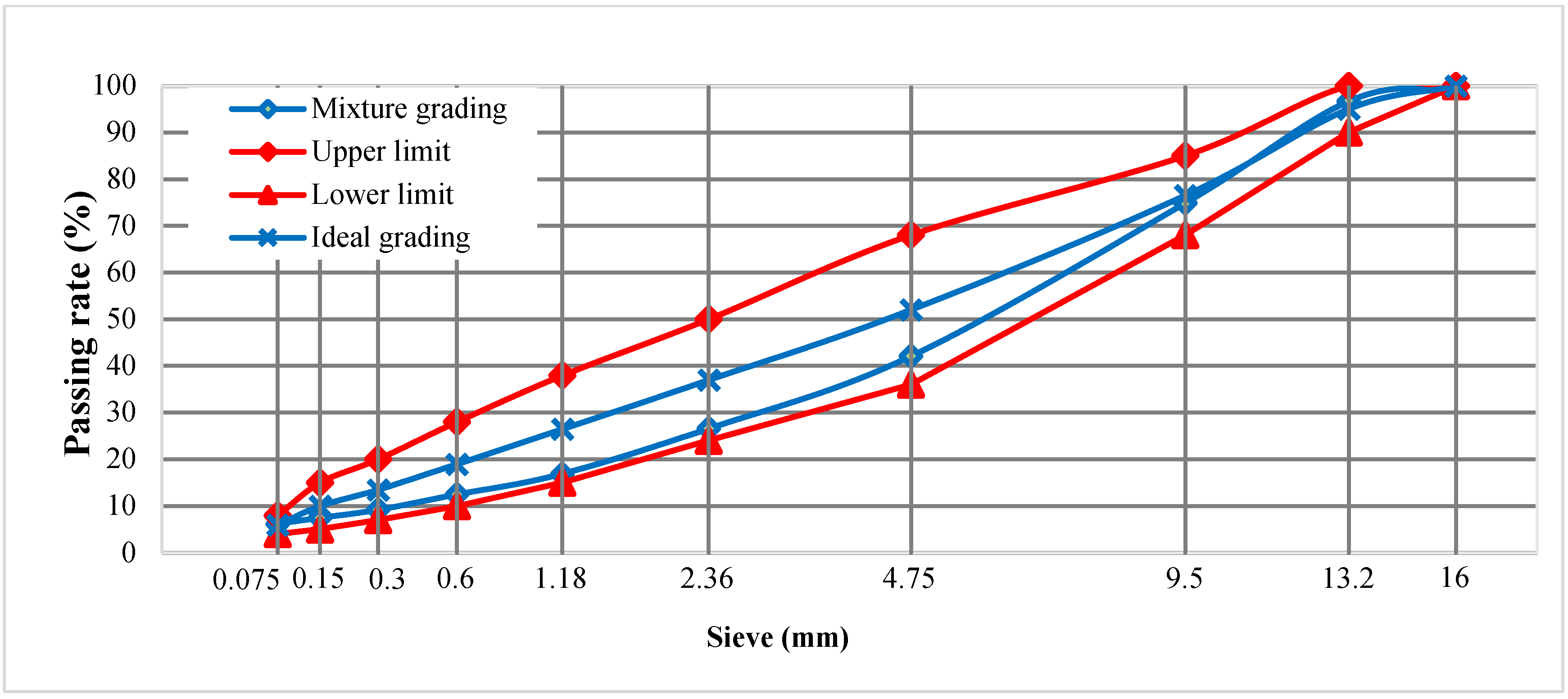



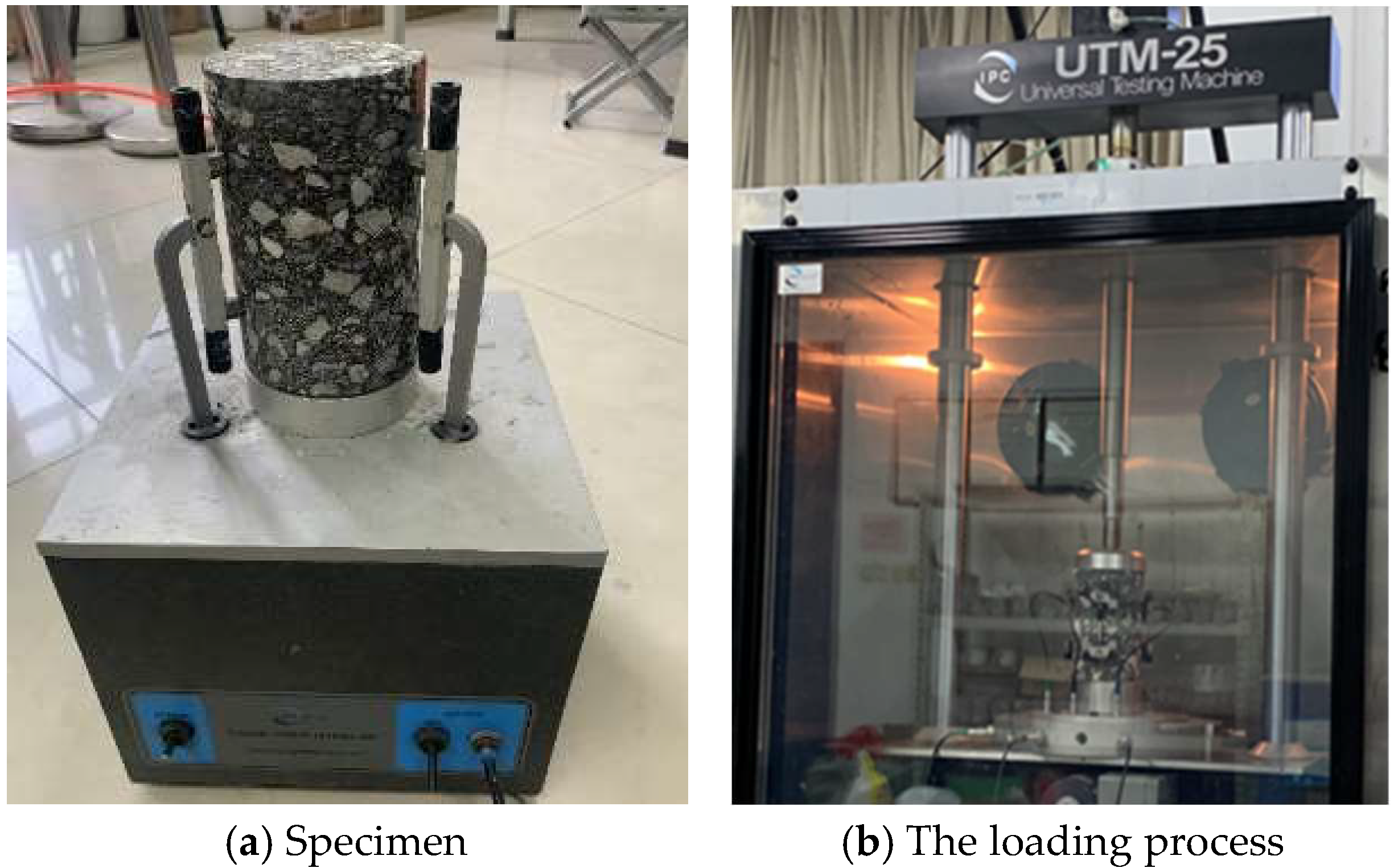

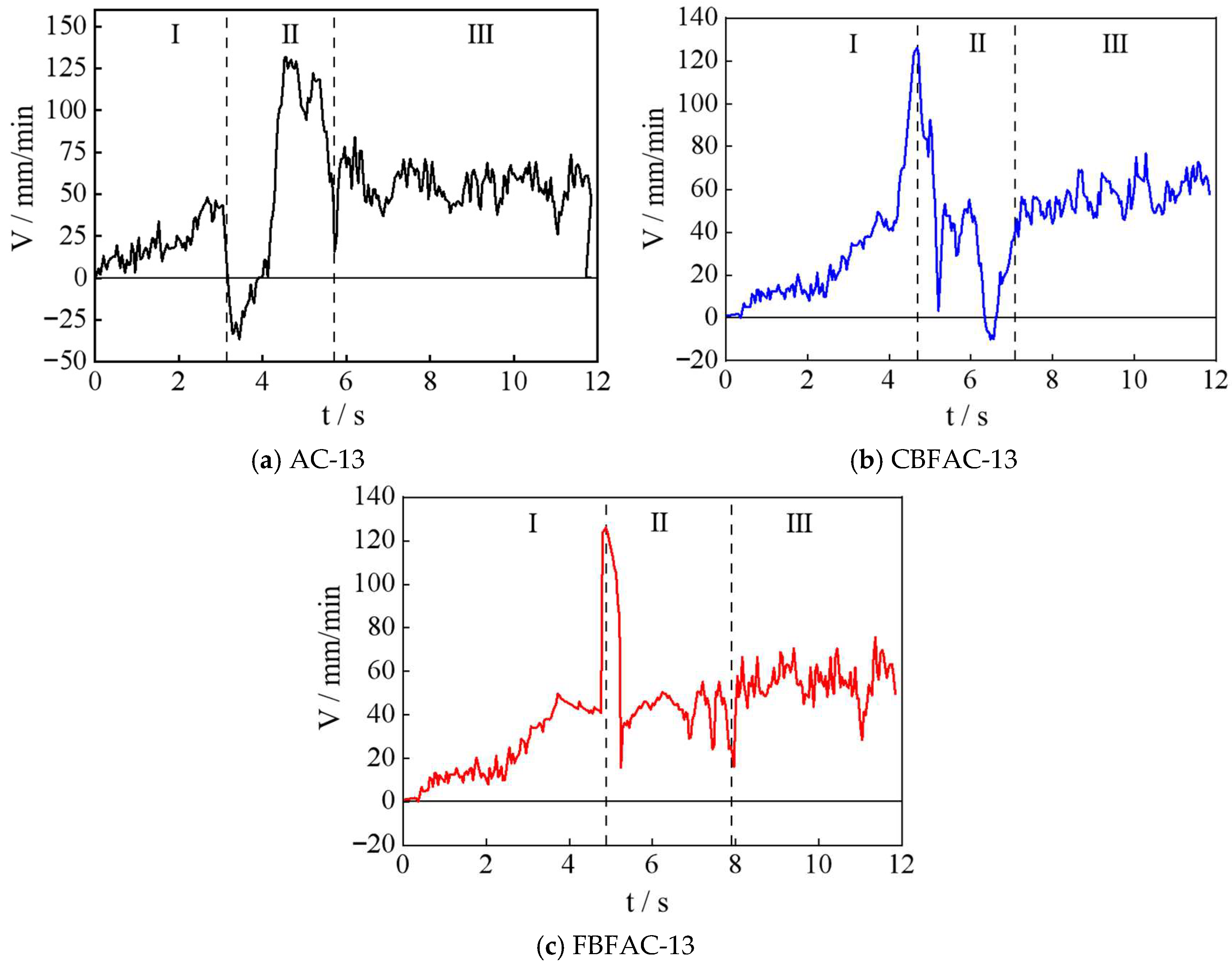

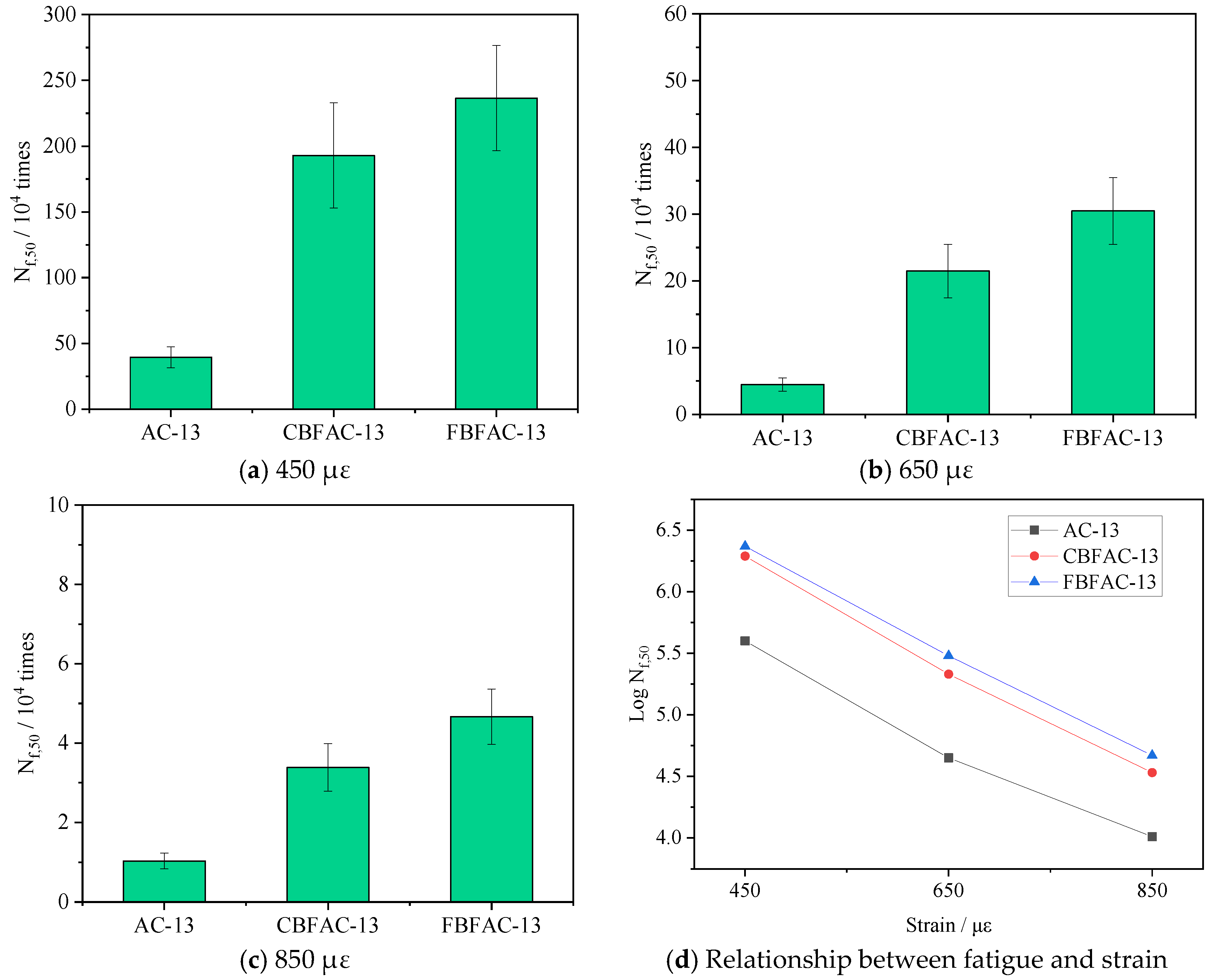


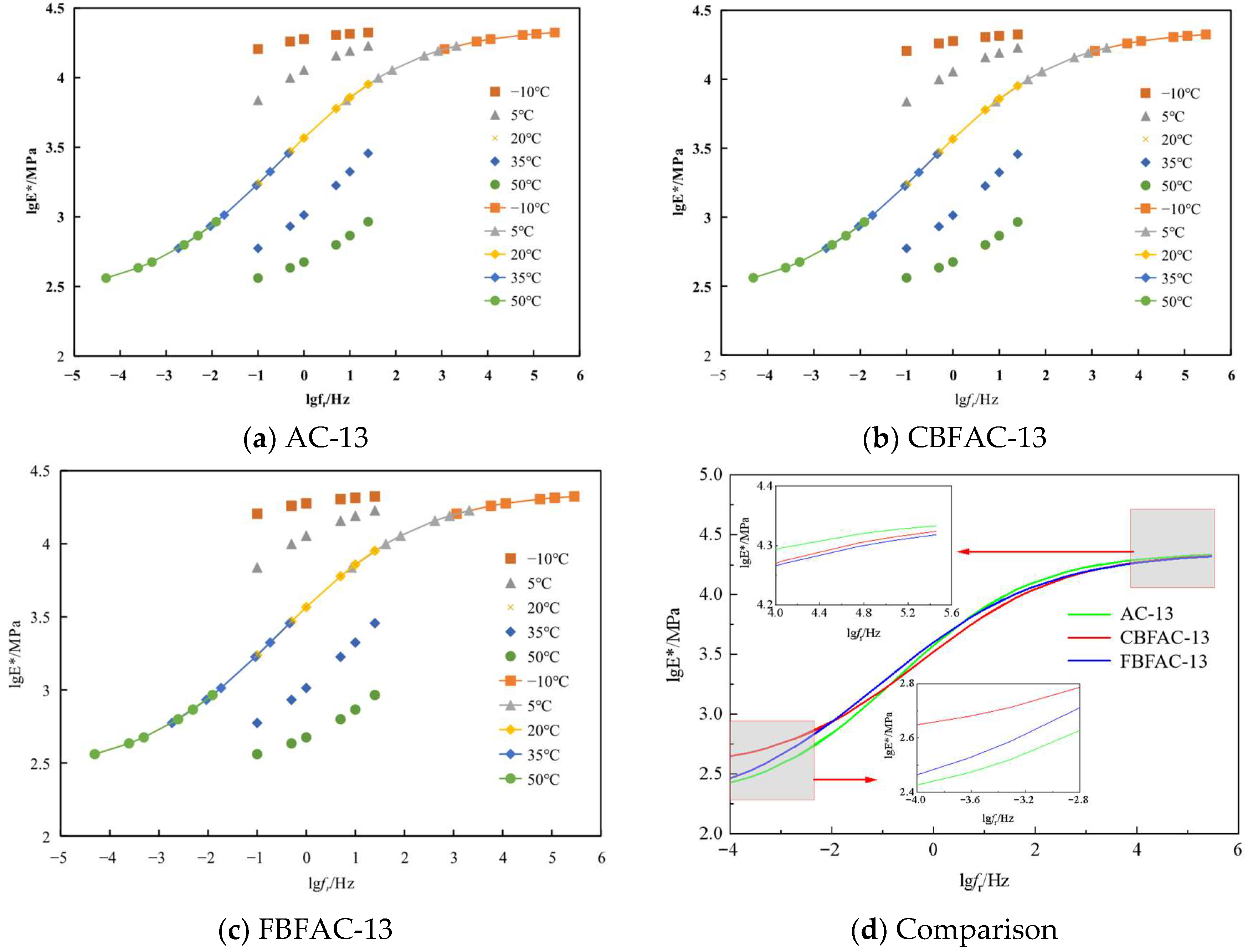
| Properties | CBF | FBF |
|---|---|---|
| Diameter/μm | 16 ± 0.7 | 10~20 |
| Length/mm | 6 ± 0.5 | 4~7 |
| Density/g·cm−3 | 2.76 | 2.82 |
| Oil absorption rate/% | 104 | 230 |
| pH | 7.1 | 7.4 |
| Types of Asphalt Mixture | Fatigue Equation | R2 |
|---|---|---|
| AC-13 | logNf = 7.3371 − 0.0039 με | 0.987 |
| CBFAC-13 | logNf = 8.2433 − 0.0044 με | 0.997 |
| FBFAC-13 | logNf = 8.2692 − 0.0042 με | 0.999 |
Disclaimer/Publisher’s Note: The statements, opinions and data contained in all publications are solely those of the individual author(s) and contributor(s) and not of MDPI and/or the editor(s). MDPI and/or the editor(s) disclaim responsibility for any injury to people or property resulting from any ideas, methods, instructions or products referred to in the content. |
© 2025 by the authors. Licensee MDPI, Basel, Switzerland. This article is an open access article distributed under the terms and conditions of the Creative Commons Attribution (CC BY) license (https://creativecommons.org/licenses/by/4.0/).
Share and Cite
Shi, Q.; Pei, Z.; Lou, K. Research on the Influence of Fibers on the Mechanical Properties of Asphalt Mixtures. Materials 2025, 18, 4971. https://doi.org/10.3390/ma18214971
Shi Q, Pei Z, Lou K. Research on the Influence of Fibers on the Mechanical Properties of Asphalt Mixtures. Materials. 2025; 18(21):4971. https://doi.org/10.3390/ma18214971
Chicago/Turabian StyleShi, Qinyu, Zhaohui Pei, and Keke Lou. 2025. "Research on the Influence of Fibers on the Mechanical Properties of Asphalt Mixtures" Materials 18, no. 21: 4971. https://doi.org/10.3390/ma18214971
APA StyleShi, Q., Pei, Z., & Lou, K. (2025). Research on the Influence of Fibers on the Mechanical Properties of Asphalt Mixtures. Materials, 18(21), 4971. https://doi.org/10.3390/ma18214971





